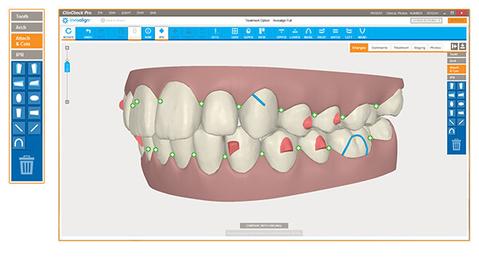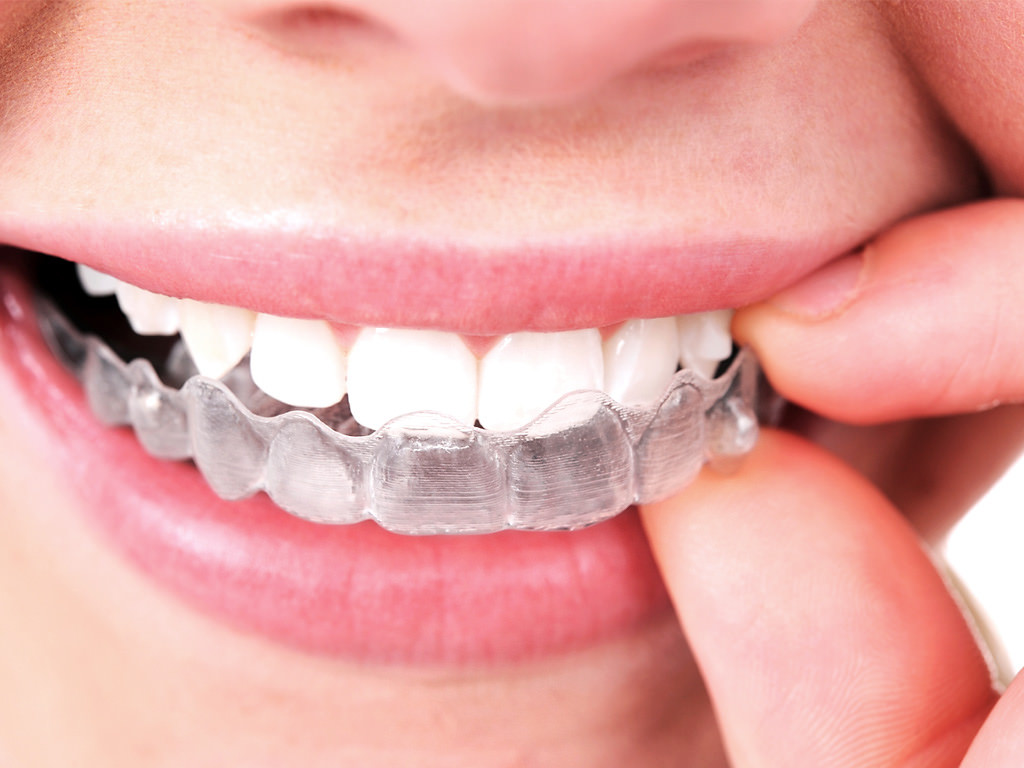In 1997, Align Technology disrupted the world of orthodontics with an alternative to braces. Their new product was Invisalign, a device that promised to straighten teeth without metal, or even clear plastic braces. Since then, other brands have introduced similar transparent teeth alignment trays. And now, Align Technology also produces trays for Smile Direct Club, which takes the concept one step further by offering patients a DIY option for straightening teeth.
If we were to compare Smile Direct Club vs. Invisalign, which one would come out on top?
The Alignment Tray Concept
Traditional braces use gentle force to redirect teeth into their desired place. This is done by attaching brackets directly to the teeth and connecting them with wire. Braces can correct crooked teeth, crowding, and gaps. They can also fix more severe malocclusions such as overbite, underbite, or crossbite.
Alignment trays also use gentle pressure to move teeth. But instead of being attached, they are made of flexible plastic that fits over the entire upper and lower set of teeth. The patient wears them for 20-22 hours each day and removes them to eat, drink, and brush.

Patients receive a series of trays, each meant to be worn for about two weeks before moving on to the next tray. The trays are custom made to fit the patient based on impressions taken at the beginning of the process.
Alignment trays work well for mild to moderate issues like gaps, crowding, and mildly crooked teeth. Those with more serious problems may not be good candidates for the treatment. Patients who can choose alignment trays over braces often do so because they are more discreet and take less time to show results. The fact that they’re removable and are usually more comfortable is also a plus.
Smile Direct Club vs. Invisalign: Overview
Invisalign and Smile Direct Club both offer transparent aligner tray methods for straightening teeth. The biggest difference between the two is that Invisalign is sold, administered, and monitored by dentists and orthodontists.
Smile Direct Club uses remote teledentistry to sell trays directly to the consumer via the postal service. In a sense, they are “cutting out the middleman” who in this case is the dentist or orthodontist. They employ licensed dentists and orthodontists, but the patient has no direct interaction with them. As Smile Direct’s website describes it, it is a “doctor-directed at-home” process.
With Smile Direct, patients are responsible for creating their own molds for their teeth. They are also the only ones observing their progress since a dentist isn’t following up. As a result, Invisalign costs more than Smile Direct Club, even though the actual trays a patient receives are very similar.
The Popularity of DIY and Online Preferences…and the Pushback
It’s easy to understand the appeal of Smile Direct Club’s concept in today’s culture. We can—and many of us do—buy nearly everything online instead of visiting a brick and mortar business. Online purchases are convenient, and for people who are house-bound or live in remote areas of the country, they are often the only option.
The American Association of Orthodontists feels strongly enough about the drawbacks of direct-to-consumer orthodontics companies like Smile Direct Club, that they have issued a consumer alert. Their primary concern is that the lack of in-person interaction with a dental professional. They acknowledge that individuals must gauge for themselves the risks vs. rewards of the product. The alert outlines several questions to ask to help with the decision, focusing on the following concerns:
- Diagnostics: Are your teeth and gums healthy enough for orthodontic treatment? Is the proposed treatment the right one for you?
- Supervision and Follow Up: Will you be solely responsible for gauging progress? If the trays aren’t working as expected or need to be tweaked, is there something that can be done?
- Problems: Who can you contact if you have issues with the product?
Patients should give serious thought to exactly what is and is not covered by the do-it-yourself methods used by Smile Direct Club.
Legalities
The AAO has also issued complaints in 36 states stating that Smile Direct Club is in violation of dental-practice statutes and that such dental procedures are best done under the supervision of dental professionals. Two states, Georgia and Alabama, have agreed and have put restrictions on the way Smile Direct operates.
Despite the backlash, Smile Direct Club continues to grow. There is a market for a fast, low-cost way of straightening teeth with the convenience of skipping the middleman—in this case, the dentist or orthodontist. For the right candidate, it can be a good option that gets results.
Comparing Cost and Time
If getting a quick fix at a low cost is the only factor in deciding between Smile Direct Club vs. Invisalign, Smile Direct is the clear winner.
Treatment with Invisalign costs between $3000 and $8000 and takes an average of 12 to 18 months, depending on the severity of the problems. Smile Direct can take as little as six months and charges about $1850 for treatment.
But cost and time are rarely the only things to consider. Just as braces are better at fixing more complex dental issues than aligner trays, Invisalign is better for some things than Smile Direct. Smile Direct does well with crowding and gapping of the front six or eight teeth. In cases of bite correction, moving molars, or significant tooth rotation, Invisalign is more effective.
While the promise of low cost and short treatment time might be attractive, patients must consider their unique alignment issues and the results they’re hoping to see.
What it’s Like to Get Invisalign
When a patient visits a dentist or orthodontist for Invisalign, treatment follows these steps:
- Impressions of upper and lower teeth are made. Traditional dental impressions are made by placing a tray filled with a putty-like compound over the teeth to make an indentation. From this mold, a 3-D plaster or plastic model is made. If the dentist has an intraoral scanner, a 3-D image is created digitally on a computer screen. X-rays will also show the root shape and bone structure, helping the orthodontist form a plan for straightening the teeth.
- At a lab, technicians use the impressions to create a series of aligner trays that when worn will move the teeth into their desired location.
- The dentist delivers to the trays to the patient. They may also add tooth-colored attachments or “buttons” to the teeth. These help Invisalign trays click into place and add a little more force when moving the teeth.
- The patient will visit the dentist or orthodontist every four to six weeks to monitor progress and make adjustments as needed.
What it’s Like to Use Smile Direct Club
With Smile Direct Club, there is little or no interaction with a dental professional.
- Smile Direct offers two options for impressions. They have retail locations called Smile Stores where a technician can take a digital impression with a 3-D scanner. The number of Smile Stores is growing, but some states still only have one or two. If a patient is not lucky enough to have one nearby, they will receive a kit in the mail with instructions and materials to make a mold of their teeth on their own. They will also be asked for photos of their teeth from a few different angles. A dental professional will be assigned to the case and will create a treatment plan.
- As with Invisalign, custom made trays are created from the impressions by technicians in a lab.
- The trays are mailed directly to the patient with instructions about how to use them.
- About every 90 days, the assigned dental professional contacts the patient via an online account to monitor progress.
Dentists vs. Do-It-Yourself
Some dentists and orthodontists aren’t thrilled about patients taking their dental care into their own hands. True, this may be partly for business reasons. Smile Direct Club represents competition to traditional dental and orthodontic practices that offer Invisalign or any other teeth straightening options. But aside from that, they have some valid arguments.
Impressions
Most dentists agree that even with training, it can take years to master the art of getting a good impression. And even in the controlled environment of their office, they’re not always perfect and sometimes need to be repeated.
Since digital impressions at Smile Direct Club’s Smile Shops aren’t accessible to everyone, the majority of Smile Direct impressions are made at home by novices. There is a lot of room for error in a procedure that needs to be precise.
Personalized Dental Care
Patients who go to their regular dental professional for Invisalign have the advantage of an existing relationship with someone who knows their dental history. A dentist can take X-rays, see the patient’s bite and how the teeth fit together, view previous dental work, and examine the condition of the gums. All of these are important in determining if a patient is a good candidate for an alignment tray straightening method—and none of them can be done when getting care remotely.
The regular visits to the dentist during Invisalign treatment also allow the dentist to assess the progress and address any problems or questions. Pain or discomfort can be looked into and tweaks can be made to the straightening plan if necessary. The patient can also call or visit the dental practice for help with lost or broken Invisalign trays.
While the local dental office has specific hours of operation, Smile Direct Club advertises a 24/7 approach to customer service. But it is just that—customer service. Patients may be able to reach someone anytime they call or email. But that someone will not be able to see a problem in person, and therefore may not be equipped to offer a solution.
Dr. David Maricondo, a consultant with the Dental Health Society, talks about each alternative here:
The Bottom Line on Smile Direct Club vs. Invisalign
For those candidates who are on a limited budget, have minor alignment issues, and are comfortable doing some of the work themselves, Smile Direct Club might be the right choice. For others, Invisalign may be a better product for their problem. They may also prefer the personal attention they will get from a dentist or orthodontist.
Whether you pick a do-it-yourself approach or put yourself in the hands of a professional, it is always best to ask questions. Know the pros of cons of both Smile Direct Club and Invisalign before making your choice.
If you’d like to discuss teeth straightening options with a dentist or orthodontist, consider using our online search tool to find one near you.


